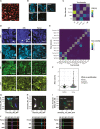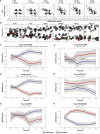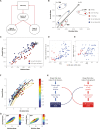Visual barcodes for clonal-multiplexing of live microscopy-based assays
- PMID: 35585055
- PMCID: PMC9117331
- DOI: 10.1038/s41467-022-30008-0
Visual barcodes for clonal-multiplexing of live microscopy-based assays
Abstract
While multiplexing samples using DNA barcoding revolutionized the pace of biomedical discovery, multiplexing of live imaging-based applications has been limited by the number of fluorescent proteins that can be deconvoluted using common microscopy equipment. To address this limitation, we develop visual barcodes that discriminate the clonal identity of single cells by different fluorescent proteins that are targeted to specific subcellular locations. We demonstrate that deconvolution of these barcodes is highly accurate and robust to many cellular perturbations. We then use visual barcodes to generate 'Signalome' cell-lines by mixing 12 clones of different live reporters into a single population, allowing simultaneous monitoring of the activity in 12 branches of signaling, at clonal resolution, over time. Using the 'Signalome' we identify two distinct clusters of signaling pathways that balance growth and proliferation, emphasizing the importance of growth homeostasis as a central organizing principle in cancer signaling. The ability to multiplex samples in live imaging applications, both in vitro and in vivo may allow better high-content characterization of complex biological systems.
© 2022. The Author(s).
Conflict of interest statement
R.S. received a grant from Merck EMD Serono, is a paid adviser to Curesponse, and Baccine and is serving on the SAB of Micronoma. The remaining authors declare no competing interests.
Figures






Similar articles
-
Improved Optical Multiplexing with Temporal DNA Barcodes.ACS Synth Biol. 2019 May 17;8(5):1100-1111. doi: 10.1021/acssynbio.9b00010. Epub 2019 Apr 16. ACS Synth Biol. 2019. PMID: 30951289
-
Genomic barcoding for clonal diversity monitoring and control in cell-based complex antibody production.Sci Rep. 2024 Jun 25;14(1):14587. doi: 10.1038/s41598-024-65323-7. Sci Rep. 2024. PMID: 38918509 Free PMC article.
-
Polylox barcoding reveals haematopoietic stem cell fates realized in vivo.Nature. 2017 Aug 24;548(7668):456-460. doi: 10.1038/nature23653. Epub 2017 Aug 16. Nature. 2017. PMID: 28813413 Free PMC article.
-
Cellular barcoding to decipher clonal dynamics in disease.Science. 2022 Oct 14;378(6616):eabm5874. doi: 10.1126/science.abm5874. Epub 2022 Oct 14. Science. 2022. PMID: 36227997 Free PMC article. Review.
-
Progress in the use of DNA barcodes in the identification and classification of medicinal plants.Ecotoxicol Environ Saf. 2021 Jan 15;208:111691. doi: 10.1016/j.ecoenv.2020.111691. Epub 2020 Nov 28. Ecotoxicol Environ Saf. 2021. PMID: 33396023 Review.
Cited by
-
pYtags enable spatiotemporal measurements of receptor tyrosine kinase signaling in living cells.Elife. 2023 May 22;12:e82863. doi: 10.7554/eLife.82863. Elife. 2023. PMID: 37212240 Free PMC article.
-
Stepwise Stiffening/Softening of and Cell Recovery from Reversibly Formulated Hydrogel Interpenetrating Networks.Adv Mater. 2024 Nov;36(44):e2404880. doi: 10.1002/adma.202404880. Epub 2024 Sep 6. Adv Mater. 2024. PMID: 39240007
-
Pooled multicolour tagging for visualizing subcellular protein dynamics.Nat Cell Biol. 2024 May;26(5):745-756. doi: 10.1038/s41556-024-01407-w. Epub 2024 Apr 19. Nat Cell Biol. 2024. PMID: 38641660 Free PMC article.
-
Virtual screening for small-molecule pathway regulators by image-profile matching.Cell Syst. 2022 Sep 21;13(9):724-736.e9. doi: 10.1016/j.cels.2022.08.003. Epub 2022 Sep 2. Cell Syst. 2022. PMID: 36057257 Free PMC article.
-
Stepwise Stiffening/Softening of and Cell Recovery from Reversibly Formulated Hydrogel Double Networks.bioRxiv [Preprint]. 2024 Apr 8:2024.04.04.588191. doi: 10.1101/2024.04.04.588191. bioRxiv. 2024. Update in: Adv Mater. 2024 Nov;36(44):e2404880. doi: 10.1002/adma.202404880. PMID: 38645065 Free PMC article. Updated. Preprint.
References
Publication types
MeSH terms
Substances
LinkOut - more resources
Full Text Sources
Research Materials

